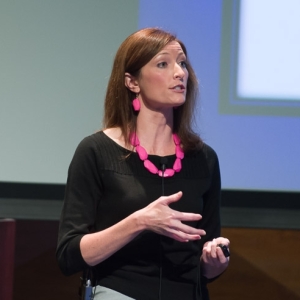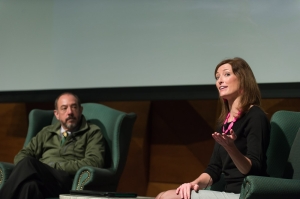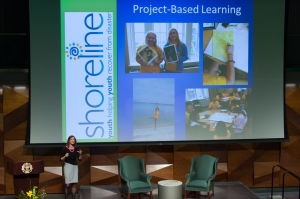
After spending nearly a decade studying children in the aftermath of disaster, Colorado State University Associate Professor Lori Peek has plenty of evidence that suggests our preconceived notions about how youth are affected by such events are out of line with reality.
Peek, the third speaker in the President’s Community Lecture Series, talked at length Tuesday night at the Lory Student Center Theater about her research following disasters like Hurricane Katrina and the BP/Deepwater Horizon oil spill in the Gulf Coast region.
Among the myths she dismissed:
- Like rubber balls, children always bounce back. We tend to view children as being blissfully unaware of, and mostly unaffected by, disasters.
- Children are helpless victims. We cast children as powerless and fragile, always rendered completely incapable of acting in the face of disaster.
- Disasters as equal-opportunity events. We tend think of disasters affecting all children equally instead of focusing on economic, geographic, racial and other factors.
She said getting beyond those preconceived notions is crucial to understanding how kids process — and respond to — the disasters they have faced.
“Once our lens of vision is more clear and less cloudy, we can get a better idea of how disasters actually do affect kids’ lives,” she said.
Stories of triumph over adversity

Peek, an associate professor of sociology, gave three powerful accounts of how children and youth have dealt with natural disasters, showing how they responded to adversity. There was the 11-year-old in New Orleans who, in the face of flooding after Hurricane Katrina, advised his mom to wrap his nine-month-old sister in a bed sheet around her and wade the family to safety as the waters were rising.
A 16-year-old resident of Joplin, Mo., responded to the tornado that hit her community in May 2011 by helping organize a campaign in her community to paint a mural and then worked with her parents to paint a “spirit tree” as a symbol of hope and renewal.
And then there was the 21-year-old college student in Christchurch, New Zealand, which was rocked by an earthquake in February 2011, who used Facebook to organize the “Student Volunteer Army” to help with the clean-up effort.
In an audience participation exercise, only a handful of attendees could say they had experienced three natural disasters in their lifetimes. Studies have shown that on the Gulf Coast, those between the ages of 14 and 18 report living through an average of 3.4 natural disasters. Peek said that while children can take a leading role in recovering from such events, those disasters can also take a toll.
“If we’re all healthy and happy, with a full tank of gas, what if each disaster takes away a quarter of a tank?” she asked.
The SHOREline project
Peek also discussed how the BP oil spill spurred the launch of the SHOREline Project, a partnership between CSU’s Center for Disaster and Risk Analysis, Columbia University’s National Center for Disaster Preparedness, and the Children’s Health Fund. The “SHORE” in SHOREline stands for Skills, Hope, Opportunity, Recovery and Engagement.

Peek, co-director of the Center for Disaster and Risk Analysis, described how she and her fellow researchers helped establish SHOREline groups in five high schools in the Gulf Coast region ravaged by Katrina, the BP spill and other disasters. SHOREline is a youth-empowerment program that seeks to provide an opportunity to make fundamental changes in the lives of disaster-affected youth, their families, their communities and beyond. Peek described the projects that each group came up with, and how those efforts helped their communities be more prepared for natural disasters. She said students were eager to involve adults and other youths in the process.
“They said, ‘We will go to great lengths if we know that what we’re doing will help other people,’” she told the audience. “They engage better when they can use their hands, hearts and minds.”
She showed a video created by the SHOREline students, then took questions from the audience. In response to one comment about the high rate of burnout among social workers, Peek acknowledged that “compassion fatigue” is a very real problem.
“You have to be kind of an optimist to go into this field,” she said, adding that her students and colleagues – as well as the stories of hope and survival that she hears from those who lived through disasters – keep her going.
“I am profoundly concerned with disadvantaged communities,” Peek said. “Almost every waking hour I am thinking of disaster in some way. But it also, on a daily basis, reminds me of the power and capacity to make a difference in others’ lives.”
About the Community Lecture Series
The Community Lecture Series began in January as CSU’s gift to the community to help celebrate the 150th birthday of Fort Collins. Previous speakers include Dr. Stephen Withrow, retired head of CSU’s groundbreaking Flint Animal Cancer Center in the CSU College of Veterinary Medicine and Biomedical Sciences, and Diana Wall, a world-renowned soil ecologist and founder of CSU’s School of Global Environmental Sustainability.
The lectures are free and open to the public, and include a post-lecture reception. The next lecture in November will feature Bryan Willson, co-director of CSUs Engines and Energy Conversion Lab.